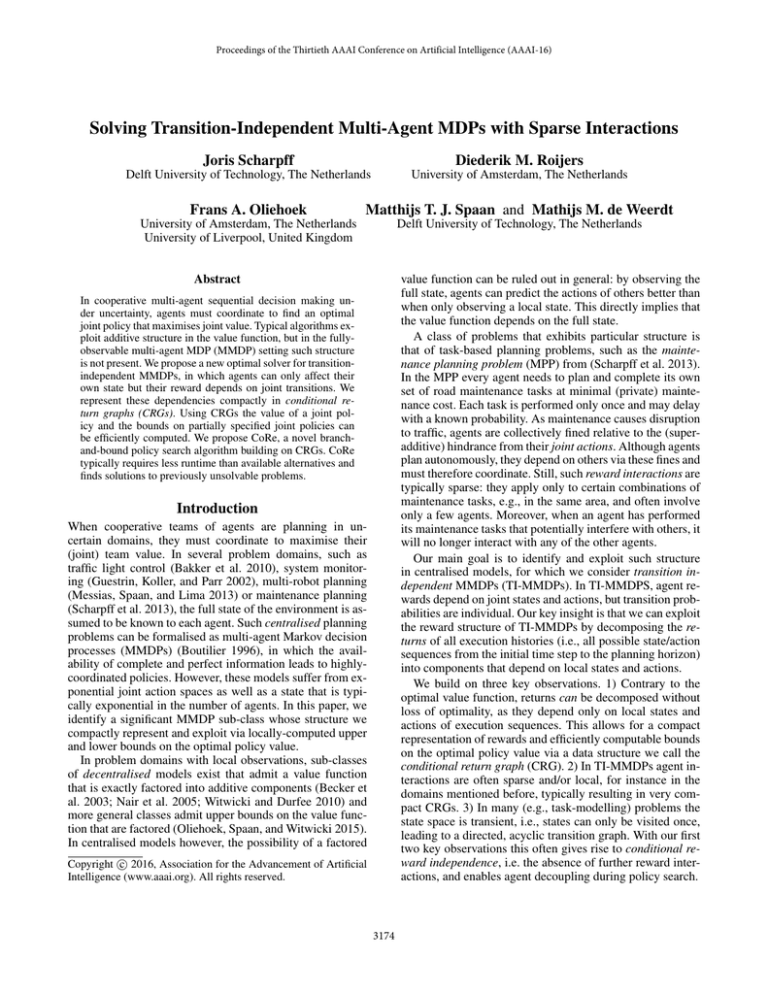
Proceedings of the Thirtieth AAAI Conference on Artificial Intelligence (AAAI-16)
Solving Transition-Independent Multi-Agent MDPs with Sparse Interactions
Joris Scharpff
Diederik M. Roijers
Delft University of Technology, The Netherlands
University of Amsterdam, The Netherlands
Frans A. Oliehoek
Matthijs T. J. Spaan and Mathijs M. de Weerdt
University of Amsterdam, The Netherlands
University of Liverpool, United Kingdom
Delft University of Technology, The Netherlands
value function can be ruled out in general: by observing the
full state, agents can predict the actions of others better than
when only observing a local state. This directly implies that
the value function depends on the full state.
A class of problems that exhibits particular structure is
that of task-based planning problems, such as the maintenance planning problem (MPP) from (Scharpff et al. 2013).
In the MPP every agent needs to plan and complete its own
set of road maintenance tasks at minimal (private) maintenance cost. Each task is performed only once and may delay
with a known probability. As maintenance causes disruption
to traffic, agents are collectively fined relative to the (superadditive) hindrance from their joint actions. Although agents
plan autonomously, they depend on others via these fines and
must therefore coordinate. Still, such reward interactions are
typically sparse: they apply only to certain combinations of
maintenance tasks, e.g., in the same area, and often involve
only a few agents. Moreover, when an agent has performed
its maintenance tasks that potentially interfere with others, it
will no longer interact with any of the other agents.
Our main goal is to identify and exploit such structure
in centralised models, for which we consider transition independent MMDPs (TI-MMDPs). In TI-MMDPS, agent rewards depend on joint states and actions, but transition probabilities are individual. Our key insight is that we can exploit
the reward structure of TI-MMDPs by decomposing the returns of all execution histories (i.e., all possible state/action
sequences from the initial time step to the planning horizon)
into components that depend on local states and actions.
We build on three key observations. 1) Contrary to the
optimal value function, returns can be decomposed without
loss of optimality, as they depend only on local states and
actions of execution sequences. This allows for a compact
representation of rewards and efficiently computable bounds
on the optimal policy value via a data structure we call the
conditional return graph (CRG). 2) In TI-MMDPs agent interactions are often sparse and/or local, for instance in the
domains mentioned before, typically resulting in very compact CRGs. 3) In many (e.g., task-modelling) problems the
state space is transient, i.e., states can only be visited once,
leading to a directed, acyclic transition graph. With our first
two key observations this often gives rise to conditional reward independence, i.e. the absence of further reward interactions, and enables agent decoupling during policy search.
Abstract
In cooperative multi-agent sequential decision making under uncertainty, agents must coordinate to find an optimal
joint policy that maximises joint value. Typical algorithms exploit additive structure in the value function, but in the fullyobservable multi-agent MDP (MMDP) setting such structure
is not present. We propose a new optimal solver for transitionindependent MMDPs, in which agents can only affect their
own state but their reward depends on joint transitions. We
represent these dependencies compactly in conditional return graphs (CRGs). Using CRGs the value of a joint policy and the bounds on partially specified joint policies can
be efficiently computed. We propose CoRe, a novel branchand-bound policy search algorithm building on CRGs. CoRe
typically requires less runtime than available alternatives and
finds solutions to previously unsolvable problems.
Introduction
When cooperative teams of agents are planning in uncertain domains, they must coordinate to maximise their
(joint) team value. In several problem domains, such as
traffic light control (Bakker et al. 2010), system monitoring (Guestrin, Koller, and Parr 2002), multi-robot planning
(Messias, Spaan, and Lima 2013) or maintenance planning
(Scharpff et al. 2013), the full state of the environment is assumed to be known to each agent. Such centralised planning
problems can be formalised as multi-agent Markov decision
processes (MMDPs) (Boutilier 1996), in which the availability of complete and perfect information leads to highlycoordinated policies. However, these models suffer from exponential joint action spaces as well as a state that is typically exponential in the number of agents. In this paper, we
identify a significant MMDP sub-class whose structure we
compactly represent and exploit via locally-computed upper
and lower bounds on the optimal policy value.
In problem domains with local observations, sub-classes
of decentralised models exist that admit a value function
that is exactly factored into additive components (Becker et
al. 2003; Nair et al. 2005; Witwicki and Durfee 2010) and
more general classes admit upper bounds on the value function that are factored (Oliehoek, Spaan, and Witwicki 2015).
In centralised models however, the possibility of a factored
c 2016, Association for the Advancement of Artificial
Copyright Intelligence (www.aaai.org). All rights reserved.
3174
nite horizon of length h, and no discounting of rewards.
Definition 1. A TI-MMDP is a tuple N, S, A, T, R:
N = {1, ..., n} is a set of n enumerated agents;
S = S 1 × ... × S n is the agent-factored state space, which
is the Cartesian product of n factored states spaces S i
(composed of features f ∈ F , i.e., si = {fxi , fyi , . . .});
A = A1 × ... × An is the joint action space, which is the
Cartesian product of the n local action spaces Ai ;
T (s, a, ŝ) = i∈N T i (si , ai , ŝi ) defines a transition probability, which is the product of the local transition probabilities due to transition independence; and
R is the set of reward functions over transitions that we
assume w.l.o.g. is structured as {Re |e ⊆ N }. When e =
{i}, Ri is the local reward function for agent i, and when
|e| > 1, Re is called an interaction reward. The total team
reward per time step, given a joint state s, joint action a
and new joint
state ŝ, is the sum of all rewards:
R(s, a, ŝ) = Re ∈R Re ({sj }j∈e , {aj }j∈e , {ŝj }j∈e ).
Two agents i and j are called dependent when there exists a reward function with both agents in its scope, e.g., a
two-agent reward function Ri,j ({si , sj }, {ai , aj }, {ŝi , ŝj })
could describe the super-additive hindrance that results
when agents in the MPP do concurrent maintenance on two
nearby roads. We focus on problems with sparse interaction
rewards, i.e., reward functions Re with non-zero rewards for
a small subset of the local joint actions (e.g., Aij ⊂Ai×Aj )
or only a few agents in its scope. Of course, sparseness is
not a binary property: the maximal number of actions with
non-zero interaction rewards and participating agents (respectively α and w in Theorem 1) determine the level of
sparsity. Note that this is not a restriction but rather a classification of problems that benefit most from our approach.
The goal in a TI-MMDP is to find the optimal joint policy π ∗ which actions a maximise the expected sum of rewards V ∗ (st ), expressed by the Bellman equation:
e e e e
T (st, at, st+1 )
R (st, at, st+1 ) + V ∗(st+1 ) .
max
Here we propose conditional return policy search (CoRe),
a branch-and-bound policy search algorithm for TI-MMDPs
employing CRGs, and show that it is effective when reward
interactions between agents are sparse. We evaluate CoRe
on instances of the aforementioned MPP with uncertain outcomes and very large state spaces. We demonstrate that
CoRe evaluates only a fraction of the policy search space
and thus finds optimal policies for previously unsolvable instances and requires less runtime than its alternatives.
Related work
Scalability is a major challenge in multi-agent planning under uncertainty. In response, two important lines of work
have been developed. One line proposed approximate solutions by imposing and exploiting an additive structure in the
value function (Guestrin, Koller, and Parr 2002). This approach has been applied in a range of stochastic planning
settings, fully and partially observable alike, both singleagent (Koller and Parr 1999; Parr 1998) and multi-agent
(Guestrin, Venkataraman, and Koller 2002; Kok and Vlassis
2004; Oliehoek, Whiteson, and Spaan 2013). The drawback
of such methods is that typically no bounds on the efficiency
loss can be given. We focus on optimal solutions, required
when dealing with strategic behaviour in a mechanism (Cavallo, Parkes, and Singh 2006; Scharpff et al. 2013).
This is part of another line of work that has not sacrificed
optimality, but instead targets problem sub-classes with exploitable structure (Becker et al. 2003; Becker, Zilberstein,
and Lesser 2004; Mostafa and Lesser 2009; Witwicki and
Durfee 2010). In particular, several methods that similarly
exploit additive structure in the value function have been
shown exact, simply because the value functions of these
sub-classes are guaranteed to have such shape (Nair et al.
2005; Oliehoek et al. 2008; Varakantham et al. 2007). However, all these approaches are for decentralised models in
which actions are conditioned only on local observations.
Consequentially, optimal policies for decentralised models
typically yield lower value than the optimal policies for their
fully-observable counterparts (shown in our experiments).
Our focus is on transition-independent problems, suitable
for multi-agent problems in which the effects of activities of
agents are (assumed) independent. In domains where agents
directly influence each other, e.g., by manipulating shared
state variables, this assumption is violated. Still, transition
independence allows agent coordination at a task level, as in
the MPP, and is both practically relevant and not uncommon
in literature (Becker et al. 2003; Spaan, Gordon, and Vlassis
2006; Melo and Veloso 2011; Dibangoye et al. 2013).
Another type of interaction between agents is through
limited (global) resources required for certain actions. While
this introduces a global coupling, some scalability is achievable (Meuleau et al. 1998). Whether context-specific and
conditional agent independence remains exploitable in the
presence of such resources in TI-MMDPs is yet unclear.
at
st+1 ∈S
Re ∈R
(1)
At the last timestep there are no future rewards, so V ∗ (sh ) =
0 for every sh ∈ S. Although V ∗ (st ) can be computed
through a series of maximisations over the planning period,
e.g., via dynamic programming, it cannot be written as a sum
of independent local value functions without losing optimality (Koller and Parr 1999).
Instead, we factor the returns of execution sequences,
the sum of rewards obtained from following state/action
sequences, which is optimality preserving. We denote an
execution sequence up until time t as θt = [s0 , a0 ,
..., st−1 , at−1 , st ] and its return is the sum of its rewards:
t−1
aθ,x , sθ,x+1 ), where sθ,x , aθ,x and sθ,x+1 rex=0 R(sθ,x , spectively denote the state and joint action at time x, and the
resulting state at time x + 1 in this sequence. A seemingly
trivial but important observation is that the return of an execution sequence can be written as the sum of local functions:
t−1
Z(θt ) =
Re (seθ,x , aeθ,x , seθ,x+1 ),
(2)
Model
We consider a (fully-observable) transition-independent,
multi-agent Markov decision process (TI-MMDP) with a fi-
Re ∈R x=0
3175
rewards Ri and an action ai for an agent i, the dependent
actions of an agent j = i are
Ai (ai , j) ={aj ∈ Aj : ∃(Re ∈ Ri ) ∃(se , ae , ŝe )
ai ∈ae ∧ aj ∈ae ∧ Re (se , ae , ŝe ) = 0}.
(a)
Actions by other agents that are not dependent are (made)
anonymous in the CRG for agent i, since they do not influence the reward from the functions in Ri . A conditional
return graph (CRG) φi for agent i is then defined as follows.
Definition 2 (Conditional
Return Graph φi ). Given a dis
joint partitioning i∈N Ri of rewards, the Conditional Return Graph (CRG) φi is a directed acyclic graph with for
every stage t of the decision process a node for every reachable local state si , and for every local transition (si , ai , ŝi ),
a tree compactly representing all transitions of the agents in
scope in Ri . The tree consists of two parts: an action tree
that specifies all dependent local joint actions, and an influence tree, that contains the relevant local state transitions
included in the respective joint action.
The state si is connected to the root node v of an action
tree by an arc labeled with action ai . The action tree with
root node v is defined recursively on the remaining N =
N \ {i} agents as follows:
1. If N = ∅ take some j ∈ N , otherwise stop.
2. For every aj ∈ Ai (ai , j), create an internal node connected from v and labeled with aj .
3. Create one internal node to represent all actions of
agent j not in Ai (ai , j) (if any), labeled with ∗j .
4. For each child create a subtree with N = N \ {j} using
the same procedure.
Each leaf u of the action tree is the root node of an influence
tree. Starting again from N = N \ {i}:
1. If N = ∅ take some j ∈ N , otherwise stop.
2. If the path from si to the present node contains an action
aj ∈ Ai (ai , j), create child nodes to represent all local
state transitions of agent j compatible with aj , with arcs
labeled (sj , ŝj ) ∈ {(sj , ŝj ) : T j (sj , aj , ŝj ) > 0}.
3. For each child create a sub-tree with N = N \{j} using
the same procedure.
Finally, we add for each leaf node of the influence tree an arc
to the local state node ŝi labeled with the transition reward.
(b)
Figure 1: Example of a transition for one agent of a twoagent problem where (a) shows the complete state/transition
graph with unique rewards rx and (b) the equivalent but
more compact CRG when R1 only depends on a21 .
where seθ,x , aeθ,x and seθ,x+1 denote local states and actions from θt that are relevant for Re . Contrary to the optimal value function, (2) is additive in the reward components and can thus be computed locally. To compute the
expected policy value using (2), we sum the expected return P r(θh )Z(θh ) of all future execution sequences θh
reachable under policy π starting at s0 (denoted θh |π, s0 ):
π
V (s0 ) =
θh |π,s0
Z(θh )
h−1
T (sθ,t , π(sθ,t ), sθ,t+1 ). (3)
t=0
Now, (3) is structured such that it expresses the value in
terms of additively factored terms (Z(θh )). However, comparing (1) and (3), we see that the price for this is that we
no longer are expressing the optimal value function, but that
of a given policy π. In fact, (3) corresponds to an equation
for policy evaluation. It is thus not a basis for dynamic programming, but it is usable for policy search. Although policy
search methods have their own problems in scaling to large
problems, we show that the structure of (3) can be leveraged.
Conditional Return Graphs
We now partition the reward function into additive components Ri and assign them to agents. The local reward for
an agent i ∈ N is given by Ri = {Ri } ∪ Rei , where Rei
are the interaction rewards assigned to i (restricted to Re
where i ∈ e). The sets Ri are disjoint sub-sets of the reward
functions R. Then, a conditional return graph for agent i
is a data structure that represents all possible local returns,
for all possible local execution histories. Particularly, it is
a directed acyclic graph (DAG) with a layer for every stage
t = 0, . . . , h−1 of the decision process. Each layer contains
nodes corresponding to the reachable local states si ∈ S i of
agent i at that stage. As the goal is to include interaction
rewards, the CRG includes for every local state si , local action ai , and successor state ŝi a representation of all transitions (se , ae , ŝe ) for which si ∈ se , ai ∈ ae , and ŝi ∈ ŝe .
While a direct representation of these transitions captures
all the rewards possible, with the example DAG of Fig. 1a as
a result, we can achieve a much more compact representation by exploiting sparse interaction rewards, enabling us to
group many joint actions ae leading to the same rewards. To
make this explicit, we first define which actions of the neighbouring agents are important for Ri . Given the partition of
The labels on the path to a leaf node of an influence
tree, via a leaf node of the action tree, sufficiently specify the joint transitions of the agents in scope of the functions Re ∈ Ri , such that we can compute the reward
e e e e
a , ŝ ). Note that for each Re for which an
Re ∈Ri R (s , action is chosen that is not in A(ai , j) (a wildcard in the
action tree), the interaction reward must be 0 by definition.
In Fig. 1b an example CRG is illustrated. The local state
nodes are displayed as circles; the internal nodes as black
dots and action tree leaves as black triangles. The action arcs
are labelled a1 , a2 and ‘wildcard’ ∗2 , whereas influence arcs
are labelled (s24 → s24 ) and (s24 → s26 ). Note that Def. 2 captures the general case, but often it suffices to consider transitions (si ∪ F e\i , ae , ŝi ∪ F̂ e\i ), where F e\i is the set of state
3176
features on which the reward functions Ri depend. This is
a further abstraction: only feature influence arcs are needed,
typically resulting in much less arcs (see Fig. 2 later).
Now we investigate the maximal size of the CRGs. Let
|S max | = maxi∈N |S i |, |Amax | = maxi∈N |Ai |, w =
maxRe ∈Re |e| − 1, i.e., the maximal interaction function
scope size, and α = maxi,j∈N maxai ∈Ai |Ai (ai , j)| the
largest dependent action set size. First note that the full joint
policy search space is Θ(h|S max |2n |Amax |n ), however we
show that the use of CRGs can greatly reduce this.
Theorem 1. The maximal size of a CRG is
O( h · |Amax ||S max |2 · (α|S max |2 )w ).
(4)
Proof. A CRG has as many layers as the planning horizon h.
In the worst case, in every stage there are |S max | local state
nodes, each connected to at most |S max | next-stage local
state nodes via multiple arcs. The number of action arcs between two local state nodes si and ŝi is at most |Ai | times
the maximal number of dependent actions, αw . Finally, the
number of influence arcs is bounded by (|S max |w )2 .
Algorithm 1: CoRe(Φ, θtN , h, N )
1
2
3
Input: CRGs Φ, execution sequence θtN , horizon h, agents N
if t = h then return 0;
V∗ ←0
foreach conditionally independent subset N ⊆N given θtN do
// Compute weighted sums of bounds:
N aN )←
∀aN
t : U (sθ,t , t
4
Lmax ← maxN
a
5
t
N
N a N , sN )
T (sN
aN
t , st+1 )U (sθ,t , t
t+1
θ,t , sN
t+1
N
N a N , sN )
T (sN
aN
t , st+1 )L(sθ,t , t
t+1
θ,t , sN
t+1
// Find joint action maximising expected reward
8
9
V ∗ += maxaN VaN 11
Note that in general all actions can be dependent,
in which case the size of all n CRGs combined is
O(nh|S max |2+2w |Amax |1+w ); typically still much more
compact than the full joint policy search space unless w ≈
|N |. For many problems however, the interaction rewards
are more sparse and αw |Amax |w . Moreover, (4) gives
an upper bound on the CRG size in general, for a specific CRG φi this
bound is often expressed more tightly by
O(h·|Ai ||S i |2 · j∈N (maxai ∈Ai |Ai (ai , j)||S j |2 )), or even
|F | instead of |S| when conditioning rewards on state features is sufficient.
In addition to storing rewards compactly, we use CRGs
to bound the optimal policy value. Specifically, the maximal
(resp. minimal) return from a joint state st onwards, is an upper (resp. lower) bound on the attainable reward. Moreover,
the sum of bounds on local returns bounds the global return
and thus the global optimal value. We define the bounds recursively:
e e e
i
U (si ) =
R
max
(s
,
a
,
ŝ
)
+
U
(ŝ
)
, (5)
i
t
e
e
e
i
Lmax ← max(VaN , Lmax ) ;
10
12
N aN ) ≥ L
foreach aN
max do
t for which U (sθ,t , t
VaN ← 0
t
N and foreach sN
aN
t do
t+1 reachable from sθ,t
N
N aN , sN ) +
VaN +=T (sN
aN
t , st+1 ) R(sθ,t , t
t+1
θ,t , t
N
N
N
CoRe(Φ, θt ⊕ [at , st+1 ], h, N )
6
7
return V ∗
t
t
// update lb
t
Definition 3 (Conditional Reward Independence). Given an
execution sequence θt , two agents i, j ∈ N are conditionally
reward independent, denoted CRI (i, j, θt ), if for all future
states st , st+1 ∈ S and every future joint action at ∈ A:
h−1
Re (sx , ax , sx+1 ) = 0.
∀Re ∈ R s.t. {i, j} ⊆ e :
x=t
Although reward independence is concluded from joint
execution sequence θt , some independence can be detected
from the local execution sequence θti only, for example
when agent i completes its dependent actions. This local
conditional reward independence occurs when ∀j ∈ N :
CRI (i, j, θti ) and is easily detected from the state during
CRG generation. For each such state si , we find optimal policy πi∗ (si ) and add only the optimal transitions to the CRG.
Together this leads to the Conditional Return Policy
Search (CoRe) (Alg. 1). CoRe performs a branch-and-bound
search over the joint policy space, represented as a DAG
with nodes st and edges at , ŝt+1 , such that finding a joint
policy corresponds to selecting a subset of action arcs from
the CRGs (corresponding to at and ŝt+1 ). First, however,
the CRGs φi are constructed for the local rewards Ri of
each agent i ∈ N , assigned heuristically to obtain balanced
CRGs. The generation of the CRGs follows Def. 2 using a
recursive procedure, during which we store bounds (Eq. 5).
During the subsequent policy search CoRe detects when
subsets of agents, N ⊂ N , become conditionally reward
independent, and recurses on these subsets separately.
Theorem 2 (CoRe Correctness). Given TI-MMDP M =
N, S, A, T, R with (implicit) initial state s0 , CoRe always
returns the optimal MMDP policy value V ∗ (s0 ) (Eq. 1).
(s ,
at ,ŝ )∈φi (s )
such that φi (si ) denotes the set of local transitions available
from state si ∈ se (ending in ŝi ∈ ŝe ). The bound on the
optimal value for a joint transition (s, a, ŝ) of all agents is
U (s, at , ŝ) =
Ri (se , aet , ŝe ) + U (ŝi ) ,
(6)
i∈N
and lower bound L is defined similarly over minimal returns.
Furthermore, CRGs can exploit independence in local reward functions as a result of past decisions. In many taskmodelling MMDPs, e.g., those mentioned in the introduction, actions can be performed a limited amount of times, after which reward interactions involving that action no longer
occur. When an agent can no longer perform dependent actions, the expected value of the remaining decisions is found
through local optimisation. More generally, when dependencies between groups of agents no longer occur, the policy
search space can be decoupled into independent components
for which a policy may be found separately while their combination is still globally optimal.
Proof. (Sketch) Conditional reward independence enables
optimal decoupling of policy search, the bounds are admissible with respect to the optimal policy value and our pruning
does not exclude optimal execution sequences.1
1
3177
The full proof can be found in the extended version of this
Figure 2: The CRGs of the two agents. We omit the branches
for a2 and b2 from states s2c and s2c . The highlighted states
are locally reward independent (reward arcs are omitted).
Figure 3: Example of policy evaluation. The left graph
shows (a part of) the policy search tree with joint states and
joint actions, and the right graph the CRGs per agent.
CoRe Example
tions to states s1b and s2b are shown. Now for t = 1 CoRe
is evaluating joint action {a1 , a2 } that is reward-interacting
and thus the value of state feature f 1 is required to determine the transition in φ2 (here chosen arbitrarily as ¬f 1 ).
The corresponding execution sequence (of agent 2) is therefore θ22 = [s20 , {b1 , b2 }, s2b ∪ {f 1 ?}, {a1 , a2 }, s2ba ∪ {¬f 1 }].
If agent 1 had chosen c1 instead, we would traverse the
branch ∗1 leading to state s2ba without reward interactions.
Branch-and-bound is shown (in blue) for state sb,b , with
the rewards labelled on transitions and their bounds at the
nodes. The bounds for joint actions {a1 , a2 } and {a1 , c2 }
are [13, 16] and [12.5, 12.5], respectively, found by summing
the CRG bounds, hence {a1 , c2 } can be pruned. Note that we
can compute the expected value of {a1 , c2 } in the CRG, but
not that of {a1 , a2 } because agent 2 does not know the value
of f 1 or the probability of a1 during CRG generation.
Conditional reward independence occurs in the green
states of the policy search tree. After joint action {b1 , a2 },
the agents will no longer interact (a2 is done) and thus the
problem is decoupled. From state sb,a CoRe finds optimal
policies π1∗ (s1b ) and π2∗ (s2a ) and combines them into an optimal joint policy π ∗ (sb,a ) = π1∗ (s1b ), π2∗ (s2a ).
We present a two-agent example problem in which both
agents have actions a, b and c, but every action can be performed only once within a 2-step horizon. Action c2 of
agent 2 is (for ease of exposition) the only stochastic action
with outcomes c and c , and corresponding probabilities 0.75
and 0.25. There is only one interaction, between actions a1
and a2 , and the reward depends on feature f 1 of agent 1
being set from f 1 ? to f 1 or ¬f 1 . Thus we have one interaction reward function with rewards R1,2 (f 1 ?, {a1 , a2 }, f 1 )
and R1,2 (f 1 ?, {a1 , a2 }, ¬f 1 ), and local rewards R1 and R2 .
Figure 2 illustrates the two CRGs. On the left is the
CRG φ1 of agent 1 with only its local reward R1 , while the
CRG of agent 2 includes both the reward interaction function R1,2 and its local reward R2 . Notice that only when
sequences start with action a2 additional arcs are included
in CRG φ2 to account for reward interactions. The sequence
starting with a2 is followed by an after-state node with two
arcs: one for agent 1 performing a1 and one for its other
actions, ∗1 = {b1 , c1 }. The interaction reward depends on
what feature f 1 is (stochastically) set to, thus the influence
arcs f 1 and ¬f 1 . As the interaction reward only occurs when
{a1 , a2 } is executed, the fully-specified after-state node after a2 and ∗1 (the triangle below it) has a no-influence
arc ∅1 . All other transitions are reward independent and
captured by local transitions (s20 , b2 , s2b ) and (s20 , c2 , s2c ). Locally independent states are highlighted green, from which
only the optimal action transitions are kept in the CRG, e.g.,
only action arc c1 (and not b1 ) is included from s1a .
An example of CoRe policy search is shown in Figure 3,
with the policy search space on the left and the CRGs on
the right, now annotated with return bounds. Only several
of the branches of the full DAG and CRGs are shown to
preserve clarity. At t = 0, there are 9 joint actions with
12 result states, while the CRGs need only 3 + 4 states
and 3 + 6 transitions to represent all rewards. The execution sequence θh that is evaluated is highlighted in thick red.
This sequence starts with non-dependent actions {b1 , b2 },
resulting in joint state sb,b (ignore the bounds in blue for
now). The execution sequence at t = 1 is thus θ1 =
[s0 , {b1 , b2 }, sb,b ]. In the CRGs the corresponding transi-
Evaluation
In our experiments we find optimal policies for the maintenance planning problem (MPP, see the introduction) that
minimise the (time-dependent) maintenance costs and economic losses due to traffic hindrance. Using this domain
we conduct three experiments with CoRe to study 1) the
expected value when solving centrally versus decentralised
methods, 2) the impact on the number of joint actions evaluated and 3) the scalability in terms of agents.
First, we compare with a decentralised baseline by treating the problem as a (transition and observation independent) Dec-MDP (Becker et al. 2003) in which agents can
only observe their local state. Although the (TI-)Dec-MDP
model is fundamentally different from TI-MMDP – in the
latter decisions are coordinated on joint (i.e., global) observations – the advances in Dec-MDP solution methods
(Dibangoye et al. 2013) may be useful for TI-MMDP problems if they can deliver sufficient quality policies. That is,
since they assume less information available, the value of
paper, available at http://arxiv.org/abs/1511.09047.
3178
approximately decimates the number of evaluated joint actions compared to the DP method (green). Furthermore,
when value bounds are used (CoRe, red), this number is reduced even more, although its effect varies per instance.
Figure 4c shows the percentage of problems from the mpp
test set that are solved within 30 minutes per method (all
two-agent instances were solved and hence omitted). CoRe
solves more instances than SPUDD (black) of the 3 agent
problems (cross marks), and only CRG-PS and CoRe solve
4-agent instances. This is because CRGs successfully exploit the conditional action independence that decouples the
agents for most of the planning decisions. Only when reward
interactions may occur actions are coordinated.
As CoRe achieves a greater coverage than SPUDD, we
compare runtimes only for instances successfully solved by
the latter (Fig. 4d). We order the instances on their SPUDD
runtime (causing the apparent dispersion in CoRe runtimes)
and plot runtimes of both. CoRe solves almost all instances
faster than SPUDD, both with 2 and 3 agents. CoRe failed on
3.4% of the instances solved by SPUDD whereas SPUDD
failed 63.9% of the instances that CoRe solved.
Finally, to study the agent-scalability of CoRe, we generated a test set pyra with a pyramid-like reward interaction
structure: every first action of the k-th agent depends on the
first action of agent 2k and agent 2k + 1. Figure 4e shows
the percentage of solved instances from the pyra test for
various problem horizons. Whereas previous state-of-theart solved instances up to only 5 agents, CoRe successfully
solved about a quarter of the 10 agent problems (h = 4) and
overall solves many of the previously unsolvable instances.
107
# Evaluations
Dec-MDP / MMDP
1
0.9
0.8
0.7
0.6
0.5
0.4
0.3
0.2
rand3
(a)
rand4
rand5
105
104
103
102
101
coordint
π∗
π∗
VDEC
/VMMDP
106
Instance
(b) # joint actions evaluated
103
80
Runtime (s)
% Solved
100
60
40
20
0
5.0
6.0
7.0
8.0
9.0
10.0
Horizon length
(c) Perc. instances solved
102
101
100
10-1
Instance
(d) Run times
% Solved
100
80
60
40
20
0
2.0 3.0 4.0 5.0 6.0 7.0 8.0 9.0 10.0
Number of agents
(e) Perc. instances solved
Figure 4: Experimental results
Dec-MDP policies will at best equal that of their MMDP
counterparts, but in practice the expected value obtained
from following a decentralised policy may be lower. We investigate if this is the case in our first experiment, which
compares the expected value of optimal MMDP policies
found by CoRe with optimal Dec-MDP policies, as found
by the GMAA-ICE* algorithm (Oliehoek et al. 2013).
For this initial experiment we use two benchmark sets:
rand[h], 3 sets of 1000 random two-agent problems with
horizons h ∈ [3, 4, 5], and coordint, a set of 1000
coordination-intensive instances where poor coordination
results in low expected values. Figure 4a shows the raπ∗
π∗
/VMMDP
. In the random instances the expected
tio VDEC
values of both policies equal in approximately half of the
instances. For coordination-intensive instances coordint
decentralised policies result in worse results – on average the
reward loss is about 33%, but it can be 75% – demonstrating
that decentralised policies are inadequate for our purposes.
In our remaining experiments we used a random test
set mpp with 2, 3 and 4-agent problems (400 each) with 3
maintenance tasks, planning horizons 5 to 10, random delay probabilities and binary reward interactions. We compare CoRe against the current state-of-the-art MPP method
from (Scharpff et al. 2013), solving a compact encoding
of the problem through value iteration (SPUDD) (Hoey et
al. 1999), and a dynamic programming algorithm that maximises Eq. 1 with added domain knowledge to quickly identify and prune infeasible branches. We included CRG policy search without bounds (CRG-PS) to study the impact of
branch-and-bound.
Figure 4b shows the search space size reduction by CRGs
in this domain. Our CRG-enabled algorithm (CRG-PS, blue)
Conclusions and Future Work
In this work, we focus on optimally (and centrally) solving
fully-observable, stochastic planning problems where agents
are dependent only through interaction rewards. We partition
individual and interaction rewards per agent in conditional
return graphs, a compact and efficient data structure when
interactions are sparse and/or non-recurrent. We propose a
conditional return policy search algorithm (CoRe) that uses
reward bounds based on CRGs to reduce the search space
size, shown to be by orders of magnitude in the maintenance
planning domain. This enables CoRe to overall decrease the
runtime required compared to the previously best approach
and solve instances previously deemed unsolvable.
We consider only optimal solutions, but CRGs can be
combined with approximation in several ways. First, the reward structure of the problem itself may be approximated.
For instance, the reward function approximation of (Koller
and Parr 1999) can be applied to increase reward sparsity, or
CRG paths with relatively small reward differences may be
grouped, trading off a (bounded) reward loss for compactness. Secondly, the CRG bounds directly lead to a boundedapproximation scheme, usable in for instance the approximate multi-objective method of (Roijers et al. 2014). Lastly,
CRGs can be implemented in any (approximate) TI-MMDP
algorithm or, vice versa, any existing approximation scheme
for MMDP that preserves TI can be used within CoRe.
Although we focused on transition-independent MMDPs,
CRGs may be interesting for general MMDPs when transi-
3179
tion dependencies are sparse. This would require including
dependent-state transitions in the CRGs similar to rewardinteraction paths and is considered to be future work.
Meuleau, N.; Hauskrecht, M.; Kim, K.-E.; Peshkin, L.; Kaelbling, L. P.; Dean, T. L.; and Boutilier, C. 1998. Solving very
large weakly coupled Markov decision processes. In Proceedings of the Fifteenth National Conference on Artificial
Intelligence, 165–172.
Mostafa, H., and Lesser, V. 2009. Offline planning for communication by exploiting structured interactions in decentralized MDPs. In Proceedings of the International Joint Conference on Web Intelligence and Intelligent Agent Technologies,
volume 2, 193–200.
Nair, R.; Varakantham, P.; Tambe, M.; and Yokoo, M. 2005.
Networked distributed POMDPs: A synthesis of distributed
constraint optimization and POMDPs. Proceedings of the
Twentieth National Conference on Artificial Intelligence.
Oliehoek, F. A.; Spaan, M. T. J.; Whiteson, S.; and Vlassis,
N. 2008. Exploiting locality of interaction in factored DecPOMDPs. In Proceedings of the Int. Conf. on Autonomous
Agents and Multiagent Systems, 517–524.
Oliehoek, F. A.; Spaan, M. T. J.; Amato, C.; and Whiteson, S.
2013. Incremental clustering and expansion for faster optimal planning in decentralized POMDPs. Journal of Artificial
Intelligence Research 46:449–509.
Oliehoek, F. A.; Spaan, M. T. J.; and Witwicki, S. J. 2015.
Factored upper bounds for multiagent planning problems under uncertainty with non-factored value functions. In Proc.
of International Joint Conference on Artificial Intelligence,
1645–1651.
Oliehoek, F. A.; Whiteson, S.; and Spaan, M. T. J. 2013.
Approximate solutions for factored Dec-POMDPs with many
agents. In Proceedings of the Int. Conf. on Autonomous
Agents and Multiagent Systems, 563–570.
Parr, R. 1998. Flexible decomposition algorithms for weakly
coupled Markov decision problems. In Proceedings of Uncertainty in Artificial Intelligence, 422–430. Morgan Kaufmann
Publishers Inc.
Roijers, D. M.; Scharpff, J.; Spaan, M. T. J.; Oliehoek, F. A.;
De Weerdt, M.; and Whiteson, S. 2014. Bounded approximations for linear multi-objective planning under uncertainty.
In Proceedings of the Int. Conf. on Automated Planning and
Scheduling, 262–270.
Scharpff, J.; Spaan, M. T. J.; de Weerdt, M.; and Volker, L.
2013. Planning under uncertainty for coordinating infrastructural maintenance. In Proceedings of the Int. Conf. on Automated Planning and Scheduling, 425–433.
Spaan, M. T. J.; Gordon, G. J.; and Vlassis, N. 2006. Decentralized planning under uncertainty for teams of communicating agents. In Proceedings of the Int. Conf. on Autonomous
Agents and Multiagent Systems.
Varakantham, P.; Marecki, J.; Yabu, Y.; Tambe, M.; and
Yokoo, M. 2007. Letting loose a SPIDER on a network of
POMDPs: Generating quality guaranteed policies. In Proceedings of the Int. Conf. on Autonomous Agents and Multiagent Systems.
Witwicki, S. J., and Durfee, E. H. 2010. Influence-based
policy abstraction for weakly-coupled Dec-POMDPs. In
Proceedings of the Int. Conf. on Automated Planning and
Scheduling, 185–192.
Acknowledgements This research is supported by the
NWO DTC-NCAP (#612.001.109), Next Generation Infrastructures/Almende BV and NWO VENI (#639.021.336)
projects.
References
Bakker, B.; Whiteson, S.; Kester, L.; and Groen, F. 2010.
Traffic Light Control by Multiagent Reinforcement Learning
Systems. Studies in Computational Intelligence, Springer.
chapter Interactive Collaborative Information Systems, 475–
510.
Becker, R.; Zilberstein, S.; Lesser, V.; and Goldman, C. V.
2003. Transition-independent decentralized Markov decision
processes. In Proceedings of the Int. Conf. on Autonomous
Agents and Multiagent Systems, 41–48.
Becker, R.; Zilberstein, S.; and Lesser, V. 2004. Decentralized
Markov decision processes with event-driven interactions. In
Proceedings of the Int. Conf. on Autonomous Agents and Multiagent Systems, 302–309.
Boutilier, C. 1996. Planning, learning and coordination in
multiagent decision processes. In Proceedings of the Int.
Conf. on Theoretical Aspects of Rationality and Knowledge.
Cavallo, R.; Parkes, D. C.; and Singh, S. 2006. Optimal coordinated planning amongst self-interested agents with private
state. In Proceedings of Uncertainty in Artificial Intelligence.
Dibangoye, J. S.; Amato, C.; Doniec, A.; and Charpillet, F.
2013. Producing efficient error-bounded solutions for transition independent decentralized MDPs. In Proceedings of the
Int. Conf. on Autonomous Agents and Multiagent Systems.
Guestrin, C.; Koller, D.; and Parr, R. 2002. Multiagent planning with factored MDPs. In Advances in Neural Information
Processing Systems 14. MIT Press.
Guestrin, C.; Venkataraman, S.; and Koller, D. 2002. Contextspecific multiagent coordination and planning with factored
MDPs. In Proceedings of the Eighteenth National Conference
on Artificial Intelligence, 253–259.
Hoey, J.; St-Aubin, R.; Hu, A.; and Boutilier, C. 1999.
SPUDD: Stochastic planning using decision diagrams. Proceedings of Uncertainty in Artificial Intelligence.
Kok, J. R., and Vlassis, N. 2004. Sparse cooperative Qlearning. In Proceedings of the Int. Conf. on Machine Learning, 481–488.
Koller, D., and Parr, R. 1999. Computing factored value
functions for policies in structured MDPs. In Proceedings of
the International Joint Conference on Artificial Intelligence,
1332–1339.
Melo, F. S., and Veloso, M. 2011. Decentralized MDPs
with sparse interactions. Artificial Intelligence 175(11):1757–
1789.
Messias, J. V.; Spaan, M. T. J.; and Lima, P. U. 2013.
GSMDPs for multi-robot sequential decision-making. In Proceedings of the Twenty-Seventh AAAI Conference on Artificial
Intelligence, 1408–1414.
3180






